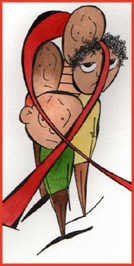|
|
the millennium development goals
 |
 |
goal 6 |
 |
 |
combat hiv aids, malaria, and other diseases
 |
 |
 |
It's a frightening reality: millions of people in the developing world die of HIV/AIDS, malaria and tuberculosis - all preventable diseases. These deadly diseases reproduce at alarming rates in conditions of extreme poverty. Goal 6 aims to stop, and begin to reverse, the spread of HIV/AIDS, the incidence of malaria and other major diseases.
Today, more than 95% of the estimated 40 million people infected with HIV live in the developing world. Similarly, malaria infects more than 500 million people each year and kills more than 1 million, with more than 90% of all cases occurring in Sub-Saharan Africa. Because of these enormously high rates of infection, in many countries education is being compromised by a dwindling supply of both teachers and students - particularly girls who must care for their younger siblings when a parent dies or becomes ill. Consequently, the impact of AIDS and other diseases is devastating to more than the individual, it affects the whole family, and often an entire community.
 |
 |
|
 |
|
 |
 only with only with
your voice
|
how youth are affected and involved

|
 |
 |
Every minute six young people between the ages of 10 and 25 are infected with HIV. Over 50% of all new infections are in young people aged 15-24, which makes them disproportionately affected by the HIV/AIDS epidemic. Young people need to receive information and preventive education in order to decrease the risk of infection. But even if youth are not directly infected, they are still affected by losing their parents or teachers to the disease.
Ways youth can take action include: going into schools and acting as peer educators and motivators to inform and counter the stigma and discrimination around HIV/AIDS; advocating by networking at conferences with the goal of incorporating youth in national strategies, advising on government policies, and distributing resources; then, through youth employment programs, youth can be trained in HIV/AIDS treatment and can help distribute medicines. Furthermore, HIV Positive youth must, wherever possible, be involved in decision-making processes.
To combat malaria, youth can get involved in procuring insecticide-treated bed nets. Vietnam, where more than 16 percent of children sleep under treated bed nets, has made significant strides in controlling malaria. But in Africa, only 7 of 27 countries with survey data reported rates of bed net use greater than 5 percent.
What would you do?
Visit our Action page for ways to implement your idea!
For more on Goal 6 please visit:
Millennium Campaign Youth Site
Millennium Campaign
World Bank
The Global Fund to Fight AIDS, Tuberculosis and Malaria
(
French,
Spanish,
Arabic,
Russian)
Africa 2015
(English and French)
Asia-Pacific 2015
(English and Japanese)
« previous | next »
|
|
 |
 |
 |
| what needs to be done |
|
| |
 |

Yara Kassem (Egypt) |

A total of 4.7 billion dollars was spent in 2003 to stop the spread of HIV/AIDS, malaria and tuberculosis. While this was an increase over what was spent in 2002 it is significantly less than the estimated $12 billion needed in 2005 and the $20 billion needed for 2006.
Governments in developing countries do not spend enough on overall health. Moreover, rural health care systems do not have enough staff or resources to treat these diseases.
Awareness, education, diagnosis and treatment for HIV/AIDS are still low in many regions. Studies in Sub-Saharan Africa have found that half of teenagers who responded did not realize that a healthy looking person could be living with HIV/AIDS. While the numbers are discouraging, there is more awareness among young people about the dangers of HIV/AIDS, thanks to education initiatives (many led by youth) in local communities. |
|
 |



